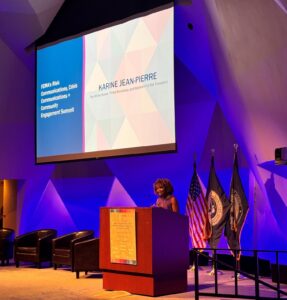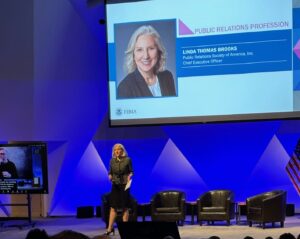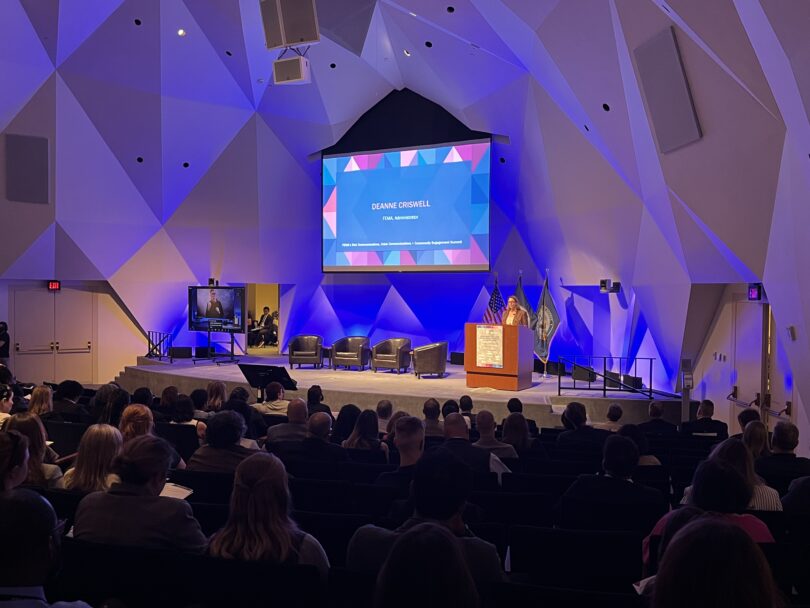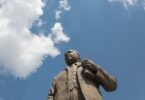On June 10, FEMA’s Office of External Affairs held its inaugural “Risk Communications, Crisis Communications + Community Engagement Summit” at the National Academy of Sciences in Washington, D.C.
The Summit addressed the growing challenges brought about by climate change, which is worsening current community problems and generating new international threats, organizers said. PRSA co-sponsored this daylong event, which included CEO Linda Thomas Brooks as one of the 40-plus thought leaders.
Throughout the day, speakers such as White House Press Secretary Karine Jean-Pierre, White House Office of Digital Strategy Director Christian Tom, and U.S. Department of State Deputy Spokesperson Nathan Tek shared insights on developing culturally competent and accessible communications, integrating behavior change insights, and implementing innovative solutions to strengthen community engagement.
Deanne Criswell, FEMA’s administrator, opened by remarking on the urgency of hosting conversations like this with communicators who are on the front lines of climate impacts and emerging all-hazard crises. She said this Summit is vital to building connections, better learning how to communicate, and assisting communities in need as emergency managers will be called on to do even more in the future.
“As the nation’s leading response, recovery and resiliency agency, FEMA has been working nonstop — with many of you here in this room — to keep up with the rapidly escalating tempo of natural disasters and hazards across the country,” she said. “I would say the days of a typical disaster season are gone. We are now dealing with persistent extreme heat, drought and cold.”
Criswell talked about her recent experiences visiting several U.S. communities devastated by storms and how listening to the stories of survivors is crucial for informing communication strategies in disaster response and recovery.
“Too often, though, we find ourselves pressed for time, doing our best to make decisions, developing communication plans in a bubble. It’s not that different from the many other bubbles that exist in cities across the country, in conference rooms and other various places across America,” she said. “But if we are operating solely from a central command center, we miss the rest of the story. We need to look into the eyes of the survivors. We need to hear their stories, see the truth on the ground and then couple that anecdotal information with data to better inform our decision-making.”

Karine Jean-Pierre Emphasizes Trust and Relationships
Jean-Pierre, who had just returned from a trip to France with President Biden for the 80th anniversary of D-Day, delivered the keynote address and acknowledged the many partners the White House works with, including the federal government, private and public sectors, emergency management and academia.
“Relationships are the backbone of effective communications and ensure we are communicating in a way that builds trust with the public,” she said. “That’s because the currency of communicators is indeed trust… if you don’t have trust, you don’t have anything. So, we have seen the consequences of what happens when communities don’t know where to turn for trusted information. There’s calamity, chaos and even catastrophe.
“We have both seen what happens when dangerous misinformation drives a wedge between communicators and the American people,” Jean-Pierre continued. “But we have also seen how trusted communicators, who meet people where they are, can break through that noise and get people critical life-saving information.”
Building trust is about more than just getting accurate information across the airwaves or onto live streams. “It’s about rapport. It’s about empathy. It’s about building relationships,” she said. “Everything that I say at the [White House] podium… you have to actually be trying to put yourself in the shoes of the person or the people that you’re talking — to have that empathy.”
Nathan Tek Stresses Clear Communication in the Fight Against Misinformation
The State Department’s deputy spokesperson also emphasized the importance of building trust and providing credible information.
While misinformation, disinformation and rumors have always been problems during disasters, Tek said we’re now living in a world in which foreign actors are jumping into the fray. “The fight against misinformation starts with all of us, and the speed and source of it presented for the challenge.”
He provided several core lessons from his experiences at the State Department. In today’s fast-paced world, timely communication is critical for shaping the narrative during crises. He said that filling the information vacuum quickly can prevent others from doing so.
“Preparing and planning are, of course, keys… but nothing will always go according to plan,” Tek said. “What a communications plan does is develop relationships and norms and obtain any advanced approvals. But don’t create an overly detailed plan and expect it to make your organization ready to meet the moment.”
Another point: Don’t hide behind legal or technical jargon. “At the State Department, we call it ‘Diplo speak,'” he said. “Audiences are relying on you to speak clearly and plainly so that they know what they need to take action.”

Linda Thomas Brooks Discusses Climate and Risk Communications
PRSA’s CEO ended the morning session by discussing climate-change communications. The subject hit home with her when she and her husband recently received a $1,400 increase in their homeowner’s insurance bill.
When Thomas Brooks called the insurance company thinking the amount was a mistake, they told her about “the number of claims they’re getting, the number of climate-related issues happening all over the country that are leading to these increased costs,” she said.
“In the communications business, we have a saying: ‘Something isn’t news until it’s local and personal,’” Thomas Brooks said. With the massive jump in her insurance bill, “Climate risk just got local and personal at my house.”
As climate change affects people’s daily lives, “This is a great opportunity for communicators,” she said. “These problems that seemed far away, esoteric or scientific are now local and personal.”
Communicators can translate dry business topics, such as infrastructure investment, into something personal and relevant for audiences: “Do you want to prevent your neighborhood-access road from flooding?”
With these local, personal approaches, PR professionals can make people feel that those risks are real to them, she said, noting that it is not just the moment of crisis that needs attention.
“It’s hours of work on the front end — the education, the planning, the resource allocation to reach internal and external audiences — that’s going to make the difference,” Thomas Brooks said. “We have an opportunity to sound the alarm without being alarmists, and a chance to inform without alienating.”
Increasingly, climate and risk communications “are everybody’s business,” Thomas Brooks said. PRSA members specializing in financial or investor communications might have to craft messages about reduced crop yields or the increased transportation and logistics costs for businesses.
“Our colleagues in health communications have to talk about the health risks associated with being in areas hit by these disasters, while our internal comms colleagues have to figure out how to talk to their employees” about climate issues, she said. To do their jobs, “your colleagues who are not risk communicators increasingly need your expertise.”
You can watch her full remarks at C-SPAN.
Top two photos courtesy of FEMA.







